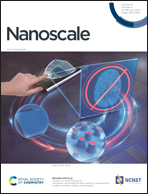Ion transport mechanisms in pectin-containing EC–LiTFSI electrolytes†
Abstract
Using all-atom molecular dynamics simulations, we report the structure and ion transport characteristics of a new class of solid polymer electrolytes that contain the biodegradable and mechanically stable biopolymer pectin. We used highly conducting ethylene carbonate (EC) as a solvent for simulating lithium–trifluoromethanesulfonimide (LiTFSI) salt containing different weight percentages of pectin. Our simulations reveal that the pectin chains reduce the coordination number of lithium ions around their counterions (and vice versa) because of stronger lithium–pectin interactions compared to lithium–TFSI interactions. Furthermore, the pectin is found to promote smaller ionic aggregates over larger ones, in contrast to the results typically reported for liquid and polymer electrolytes. We observed that the loading of pectin in EC–LiTFSI electrolytes increases their viscosity (η) and relaxation timescales (τc), indicating higher mechanical stability, and, consequently, a decrease of the mean squared displacement, diffusion coefficient (D), and Nernst–Einstein conductivity (σNE). Interestingly, while the lithium diffusivities are related to the ion-pair relaxation timescales as D+ ∼ τc−3.1, the TFSI− diffusivities exhibit excellent correlations with ion-pair relaxation timescales as D− ∼ τc−0.95. On the other hand, the NE conductivities are dictated by distinct transport mechanisms and scales with ion-pair relaxation timescales as σNE ∼ τc−1.85.



 Please wait while we load your content...
Please wait while we load your content...